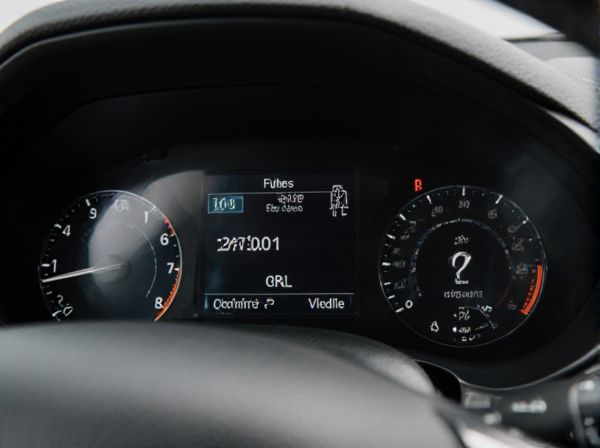
Photo illustration: Trip Computer Display vs Odometer Display
The trip computer display provides real-time data such as fuel consumption, average speed, and distance traveled on a specific trip, enhancing your ability to monitor driving efficiency. The odometer display measures the total distance the vehicle has traveled since manufacture, serving as a key indicator of overall vehicle usage and maintenance needs. Understanding the difference between these displays helps you make informed decisions about trip planning and vehicle care.
Table of Comparison
| Feature | Trip Computer Display | Odometer Display |
|---|---|---|
| Function | Shows trip distance, fuel consumption, average speed, and driving time | Records total distance traveled by the vehicle |
| Data Type | Dynamic, resets after each trip | Static, cumulative mileage |
| Purpose | Helps monitor driving efficiency and trip-specific data | Tracks overall vehicle usage and maintenance schedule |
| Display Location | Integrated within the car dashboard, often digital | Found on dashboard, analog or digital |
| Key Benefit | Offers real-time trip insights for fuel economy and time management | Provides accurate total mileage for service and resale value |
Introduction to Trip Computer and Odometer Displays
The trip computer display provides real-time data on fuel consumption, distance traveled, average speed, and estimated range, enhancing driver awareness and efficiency. The odometer display tracks the total mileage of the vehicle, essential for maintenance scheduling and resale value assessment. Both displays use digital or analog formats to deliver critical information, but the trip computer offers dynamic, trip-specific metrics, while the odometer records cumulative distance.
Definition and Purpose of a Trip Computer Display
A trip computer display is an advanced digital interface in vehicles that provides real-time data such as average fuel consumption, trip distance, driving time, and estimated range, enhancing the driver's awareness of driving efficiency and vehicle performance. Unlike the odometer display, which solely records the total distance a vehicle has traveled since manufacture, the trip computer focuses on short-term trip metrics to assist in route planning and fuel management. This specialized display supports eco-friendly driving habits and maintenance tracking by offering detailed, actionable insights beyond simple mileage counts.
Understanding the Odometer Display Function
The odometer display function measures and records the total distance a vehicle has traveled since its manufacture, providing essential data for maintenance schedules and vehicle valuation. Unlike the trip computer display, which resets and tracks individual trip distances, the odometer offers a permanent record critical for monitoring overall vehicle usage. Accurate odometer readings ensure compliance with regulatory standards and help detect potential odometer fraud.
Key Differences Between Trip Computer and Odometer Displays
Trip computer displays provide detailed information such as average fuel consumption, trip duration, and real-time mileage, enhancing driving efficiency analysis. Odometer displays specifically measure the total distance traveled by a vehicle, offering a cumulative mileage count without additional data. The key difference lies in the trip computer's dynamic, multi-functional data feedback versus the odometer's static distance recording.
Data Tracked by Trip Computer Displays
Trip computer displays track a variety of detailed data including average fuel consumption, real-time fuel efficiency, driving range, average speed, and elapsed trip time. Unlike the odometer display, which primarily measures total distance traveled by the vehicle, trip computers provide dynamic information essential for monitoring driving performance and optimizing fuel usage. Advanced trip computer systems may also log instantaneous speed, outside temperature, and navigation data.
Odometer Accuracy and Importance
Odometer displays accurately measure the total distance a vehicle has traveled, which is crucial for maintenance scheduling and resale value assessment. Unlike trip computer displays that reset and track short-term trips, odometer readings provide reliable, tamper-resistant data essential for legal and diagnostic purposes. Precision in odometer accuracy prevents fraud and ensures compliance with transportation regulations, directly impacting vehicle safety and ownership transparency.
Benefits of Using a Trip Computer Display
A trip computer display offers detailed real-time data such as average fuel consumption, distance traveled, and estimated remaining range, which enhances driving efficiency and fuel economy awareness. Unlike a basic odometer display that only shows total mileage, a trip computer provides customizable trip metrics to help drivers monitor performance and track specific journeys. This advanced functionality supports better trip planning and vehicle maintenance, contributing to overall improved driving management.
Limitations of Traditional Odometer Displays
Traditional odometer displays primarily measure total distance traveled, lacking real-time trip data such as average speed, fuel consumption, or trip duration, which limits their functionality for detailed journey analysis. They do not provide segmented trip information or reset options, making it difficult to track specific travel segments or fuel efficiency during different trips. This absence of dynamic data reduces the driver's ability to monitor driving behavior and optimize vehicle performance effectively.
Use Cases: When to Rely on Each Display
The trip computer display is ideal for monitoring real-time driving data such as average speed, fuel consumption, and trip distance, making it useful for long journeys or managing fuel efficiency. The odometer display provides the total mileage of the vehicle, essential for tracking overall wear and scheduling maintenance. Rely on the trip computer for trip-specific insights and the odometer for long-term vehicle management.
Choosing the Right Display for Your Driving Needs
Trip computer displays provide real-time data such as fuel consumption, average speed, and trip distance, ideal for drivers seeking detailed driving metrics and efficient route planning. Odometer displays offer a straightforward reading of total distance traveled, essential for tracking vehicle usage and scheduling maintenance. Selecting the right display depends on your preference for comprehensive driving insights or basic mileage tracking to enhance your driving experience and vehicle care.
 caratoz.com
caratoz.com